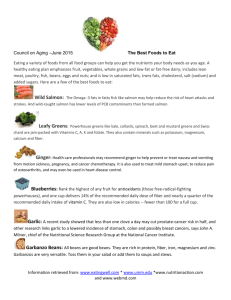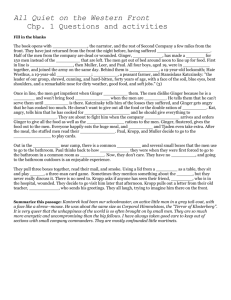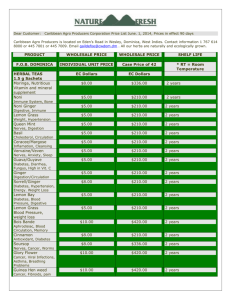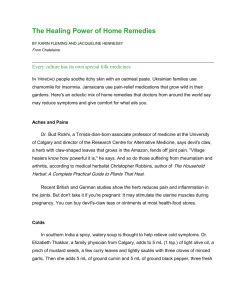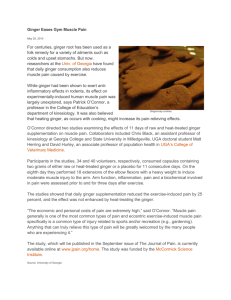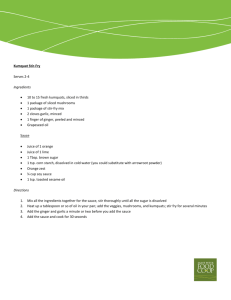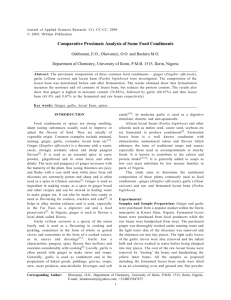Comparative Proximate Studies on Some Nigerian Food Supplements
advertisement
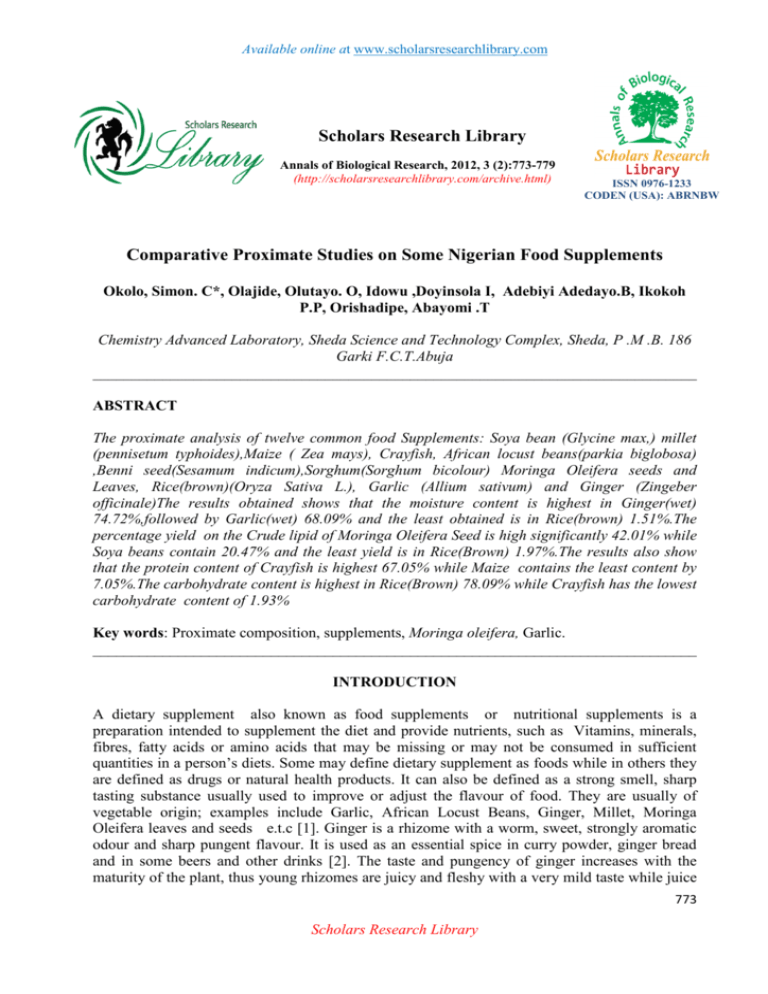
Available online at www.scholarsresearchlibrary.com Scholars Research Library Annals of Biological Research, 2012, 3 (2):773-779 (http://scholarsresearchlibrary.com/archive.html) ISSN 0976-1233 CODEN (USA): ABRNBW Comparative Proximate Studies on Some Nigerian Food Supplements Okolo, Simon. C*, Olajide, Olutayo. O, Idowu ,Doyinsola I, Adebiyi Adedayo.B, Ikokoh P.P, Orishadipe, Abayomi .T Chemistry Advanced Laboratory, Sheda Science and Technology Complex, Sheda, P .M .B. 186 Garki F.C.T.Abuja ______________________________________________________________________________ ABSTRACT The proximate analysis of twelve common food Supplements: Soya bean (Glycine max,) millet (pennisetum typhoides),Maize ( Zea mays), Crayfish, African locust beans(parkia biglobosa) ,Benni seed(Sesamum indicum),Sorghum(Sorghum bicolour) Moringa Oleifera seeds and Leaves, Rice(brown)(Oryza Sativa L.), Garlic (Allium sativum) and Ginger (Zingeber officinale)The results obtained shows that the moisture content is highest in Ginger(wet) 74.72%,followed by Garlic(wet) 68.09% and the least obtained is in Rice(brown) 1.51%.The percentage yield on the Crude lipid of Moringa Oleifera Seed is high significantly 42.01% while Soya beans contain 20.47% and the least yield is in Rice(Brown) 1.97%.The results also show that the protein content of Crayfish is highest 67.05% while Maize contains the least content by 7.05%.The carbohydrate content is highest in Rice(Brown) 78.09% while Crayfish has the lowest carbohydrate content of 1.93% Key words: Proximate composition, supplements, Moringa oleifera, Garlic. ______________________________________________________________________________ INTRODUCTION A dietary supplement also known as food supplements or nutritional supplements is a preparation intended to supplement the diet and provide nutrients, such as Vitamins, minerals, fibres, fatty acids or amino acids that may be missing or may not be consumed in sufficient quantities in a person’s diets. Some may define dietary supplement as foods while in others they are defined as drugs or natural health products. It can also be defined as a strong smell, sharp tasting substance usually used to improve or adjust the flavour of food. They are usually of vegetable origin; examples include Garlic, African Locust Beans, Ginger, Millet, Moringa Oleifera leaves and seeds e.t.c [1]. Ginger is a rhizome with a worm, sweet, strongly aromatic odour and sharp pungent flavour. It is used as an essential spice in curry powder, ginger bread and in some beers and other drinks [2]. The taste and pungency of ginger increases with the maturity of the plant, thus young rhizomes are juicy and fleshy with a very mild taste while juice 773 Scholars Research Library Okolo, Simon. C et al Annals of Biological Research, 2012, 3 (2):773-779 _____________________________________________________________________________ from old rhizomes are extremely potent and sharp and is often used as a spice in Chinese cuisines[3]. Ginger is used as ingredient in soups, as a spice in ginger bread and other recipes and can be stewed in boiling water to make ginger tea. It can also be made into candy or used as flavouring for cookies, crackers and cake. It helps to alley motion sickness and is used especially in the Far East as a digestive acid and a food preservative [4]. In Nigeria, ginger is used to flavour a local drink called Kunnu. Garlic (Allium sativum) is a specie of the onion family and is used as flavouring in cooking and pickling, sometimes in the form of whole or grated cloves and sometimes in the form of a cooked extract, as in sauces and dressing [5][6] . Garlic has a characteristic pungent spice flavour that mellows and sweetens considerably with cooking [7]. Locally, in Nigeria garlic is often paired with ginger to make stews and soups. Generally, garlic is used as supplement and on preparation of baked goods, puddings, gravies, soups, stew, meat products, non alcoholic beverage and soft candy [8]. In medicine, garlic is used as a digestive stimulant, diuretic and anti-spasmodic. African Locust beans (Parkia biglobosa), soya bean e.t.c are fermented to produce food supplements. Fermented locust beans are a well known supplement with characteristic ammoniacal odour and flavour which enhance the taste of traditional soups and sauces especially those used as accomplishment to starchy foods. It is known to contribute to the calorie and protein intake [9-11]. It is generally added to soups as low cost meat substitute by low income families in part of Nigeria. This study intend to investigate the nutritional composition of the plants commonly used as food supplement in Nigeria – Ginger, Garlic, Millets, Benni seeds, Sorghum ,Maize , Crayfish, Moringa oleifera leaves and seeds e.t.c MATERIALS AND METHODS Collection of Samples and Preparations The Sample materials (Soya beans, millet, Crayfish, African Locust beans, Benni seeds, Sorghum, Rice (brown), Garlic and Ginger) were bought in Gwagwalada Market, F.C.T Abuja. The samples were then dried in the oven at about 300C -400C for 48hrs and ground into powders. The powders were then used for analysis. The Moringa olifera Seeds and leaves were obtained from the Chemistry Advanced Laboratory (CAL), Medicinal Plant Garden, SHESTCO, Abuja. Further, air dried for two weeks and ground into powder. The powder was used for analysis [12]. Determination of Proximate composition Standard methods of the Association of official Analytical Chemists [13] were used to determine the moisture, Ash, crude fat, crude fibre, and crude protein and carbohydrate contents of each sample, all of which were carried out in triplicate [14]. Moisture content was determined by heating 2.0 g of each fresh sample to a constant weight in a crucible placed in an oven maintained at 105 0C.The ash content was determined by the incineration of 1.5 g samples placed in a muffle furnace maintained at 550 0C for 5 -8 hrs. The crude fibre was obtained by digesting 2 g of the samples with H2SO4 and NaOH and incinerating the residue in a muffle furnace maintained at 550 0C for 5 -8 hrs. The crude protein (% total nitrogen X 6.25) was determined by Kjeldahl method, using 2 g of the samples. The crude lipid 774 Scholars Research Library Okolo, Simon. C et al Annals of Biological Research, 2012, 3 (2):773-779 _____________________________________________________________________________ content was obtained by exhaustively extracting 10 g of each sample in a Soxhlet apparatus using N-Hexane as the extractant. Each analysis was carried out in triplicates. The carbohydrate content was determined by the difference i.e. deducing the sum of the percentage (moisture, ash, fibre, fat, and protein) from 100. RESULTS AND DISCUSSION Table 1: Proximate Composition(%) of Soya beans, millets, Crayfish, African locust beans, Benny seeds, Sorghum, Rice(brown),Moringa olifera Leaves and Seeds, Garlic and Ginger Parameters Soya beans Glycine max Millet Pennisetum typhoides Maize Zea mays Cray fish Africa locust beans Benni seed Sesamum indicum Sorghum bicolor Moringa seed Moringa leave powder Brown Rice Oryza sativa L Garlic Allium sativum(wet) Garlic Allium sativum(dry) Ginger Zingeber officinale(wet) Ginger Zingeber officinale(dry) Moisture 8.30±0.29 8.05±0.39 9.05±1.20 12.00±13.10 9.90±0.19 7.01±0.05 3.00±0.12 5.01±0.90 7.51±0.00 1.51±1.67 68.09±1.49 4.26±0.65 74.72±1.32 10.10±1.52 Ash 9.01±0.01 2.49±0.08 1.50±0.10 14.05±0.69 4.90±1.09 3.00±0.05 3.99±0.91 3.89±0.10 4.01±0.09 2.30±2.01 1.44±0.01 5.00±0.11 2.92±0.14 86.00±0.11 Fat 21.47±0.29 4.39±0.39 7.00±0.10 5.00±0.14 20.96±1.41 1.39±0.02 4.09±0.31 42.01±1.03 3.19±0.14 1.97±0.09 0.76±0.08 0.83±0.01 4.92±0.61 6.50±0.65 Fibre 2.45±0.22 5.02±0.24 4.68±0.49 0.24±1.92 4.07±0.33 35.10±0.12 4.01±0.01 2.97±0.49 18.02±0.55 2.51±0.71 0.69±0.16 3.05±0.15 6.07±0.64 8.30±1.65 Protein 37.51±0.15 12.09±0.31 7.05±0.01 67.05±1.57 22.44±0.55 31.03±0.29 13.09±1.23 39.61±0.99 31.01±0.57 10.01±0.45 8.54±0.66 16.55±0.01 7.57±0.59 6.56±0.50 Carbohydrate 19.02±0.30 67.8±0.05 71.21±0.05 1.93±0.01 29.45±0.20 23.09±0.15 72.00±1.44 16.01±0.01 36.10±0.26 78.09±1.22 19.48±1.43 70.31±0.11 3.80±0.34 63.54±0.35 Figure 1: moisture content (%) Statistical Analysis Results The results were presented as mean ± SEM. Data collected were analysed by ANOVA, while significant differences among the mean were determine using Duncan’s multiple range test and results were considered statistically at p<0.05 From the figure 1 above we can see that both the wet samples of ginger and garlic had the highest moisture content but significantly close in ranges which is self explanatory since they were analyzed in their wet state while rice has the lowest due to its normally dry nature. 775 Scholars Research Library Okolo, Simon. C et al Annals of Biological Research, 2012, 3 (2):773-779 _____________________________________________________________________________ Figure 2: Ash Content (%) Figure 2 investigates Crayfish as having the highest ash value follow by ginger(dry) which is closely followed by soya beans while maize,rice and garlic(wet) shows a reasonably low ash content. Figure 3: Fat Content (%) Figure 3 highlights moringa seed as having the highest fat content,follow by soya beans and African locust beans while benniseed and garlic(wet&dry)has the lowest fat content. 776 Scholars Research Library Okolo, Simon. C et al Annals of Biological Research, 2012, 3 (2):773-779 _____________________________________________________________________________ Figure 4: Crude Fibre Content (%) From fig.4 indicates benniseed as having the highest crude fibre content; follow by moringa leaves, with millet, sorghum and ginger (dry) while rice, garlic(wet) and crayfish having the lowest values. Figure 5: Protein Content (%) From fig. 5, we can deduce that crayfish has the highest protein value with moringa seed, soya beans, benniseed and moringa leaves following closely while ginnger(dry&wet) and maize having the lowest values. 777 Scholars Research Library Okolo, Simon. C et al Annals of Biological Research, 2012, 3 (2):773-779 _____________________________________________________________________________ Figure 6: Carbohydrate Content (%) From fig. 6, we can see that rice has the highest value with maize, millet, sorghum, garlic (dry) and ginger (dry) following closely with high values of carbohydrate, also while crayfish and ginger (wet) has a very low carbohydrate content, this is understandable in that crayfish showed a high value of protein and ash earlier in table 5 and 2. S.B-Soya bean; M.P.T-Millet; M.Z.M-Maize; C.F-Crayfish; A.L.B-African locust bean; B.S-Benni seed; S-Sorghum; M.S-Moringa Seeds; M.L-Moringa leaves; R(B) –Brown Rice; G.A.S.W-Wet garlic; G.A.S.DDry garlic; G.Z.O.W-Wet ginger; G.Z.O.D-Dry ginger DISCUSSION The proximate composition (%) of the nutrients in Soya beans, Millets, Crayfish, African locust beans, Benni seeds, sorghum Rice (brown),Moringa Olifera leaves and Seeds, Garlic and Ginger are presented in Table 1.The moisture content of wet Ginger 74.72% indicates the highest content compare to all other samples, next is that of wet garlic 68.09%,while the least is on the Moringa oleifera seeds 5.01%. Sorghum and millet have the value of 3% and 8.05% respectively; and Crayfish contains 12%. African locust beans and Benniseed contain 9.90% and 7.01% respectively. Soya beans and Moringa leaves powder contents contain 8.30% and 7.51% respectively. It shows that for proper drying lots of energy will be required in drying fresh Ginger, and Garlic compare to the others . The ash content of Crayfish and Soya beans are significantly high with 14.05% and 9.01% respectively with the least value in Rice (brown) 2.3%.The fat content of Moringa oleifera Seeds give a value of 42.01%,followed by Soya beans value at 21.47%.This shows that Moringa Seeds have the highest yield of fat compare to all other samples evaluated. Crayfish has the highest percentage of protein content 67.05%, which serves as a source of nitrogen in the body system along with the amino acids. Good skin, increase in growth and ability to replace the worn-out cells are the quality of protein in the body. The high protein content in Crayfish, Moringa Oleifera,Soya beans and Benniseeds implies that these food supplements can contribute significantly to the daily human protein requirement [15]. 778 Scholars Research Library Okolo, Simon. C et al Annals of Biological Research, 2012, 3 (2):773-779 _____________________________________________________________________________ Benniseeds has the highest crude fibre contents of 35.10%, while the least crude fibre is indicated in wet Garlic of 0.69%.There is significantly high carbohydrate content in Rice (brown) is 78.09%, next to Maize and Sorghum with 71.21% and 72.00% respectively while the least content of carbohydrate is found in Crayfish 1.93%. Carbohydrate is the main fuel used by the body during exercises, which are stored in muscles glycogen-a form of sugar. CONCLUSION In conclusion, the various food supplements analysed were shown to be rich in protein, carbohydrate, fibre and lipid. Crayfish is the richest source of protein, Rice (Brown) is the richest source of carbohydrate and Benniseeds is the richest source of fibre. The crude lipid content of the Moringa oleifera seed indicates the highest yield among the supplements investigated. Therefore, this group of food analysed are good source of nutritional supplements, if well blended since they have all the classes of food distributed in the wide ranges. REFERENCES [1] Redmond. W.A., 2007. Spices. Microsoft student 2008 [DVD].Microsoft corporation. [2] Spices; Exotic Flavours and Medicine; Ginger. http;//unitproj.library.ucla.edu/biomed/spices/index. [3] Burdock, G.A., 2001 Fenaroli’s handbook of flavour ingredients 4th edition.CRC Press, London, 657-682 [4] Ginger Wikipeddia http;//en.wiki/Ginger [5] Macrae, R.,R. K. Robinson and M.J. Sadler,2002.Encyclopedia of food science,food technology and nutrition. 2ndedition. Academic Press London, 3358-3362. [6] Purseglove, J.W., 1972. Tropical crops; monocotyledons. 1st edition. Longman group Limited, UK, London, 52-54. [7] Garlic. W.I. Kipedia http://en.wikipedia.org/wiki/Garlic. [8] Katzer, G.,2005.Spices pages ;Garlic(Allium sativum) http://www.uni-graz.at/-katzer/engl/Alli_sat.html. [9] Odunfa, S.A., 1985. African fermented foods.In; Wood, B.J.B(ed.) Microbiology of Fermented Foods,Vol.11,Amsterdam,Elsevier Applied Science Publishers 155-191 [10] Potter, N.N and J.H Hothkiss, 1995. Food Science. 5th edition. International Thomson Publishing, London, 46-53 [11] Umoh and Oke, 1974. Nutirtive value of lesser known oil seeds in rats. Nutritions Report International, 9:453-456 [12] Kolawole ,O.M, Kayode,R.M.O and Aina 2010. J. Journal of Agricultural Science, 2(2), 214-224. [13] AOAC., 1984 Vitamins and other nutrients. Association of official analytical Chemists. Official methods of analysis 14th edition, Arlington, V.A. [14] Ali Aberoumand, 2011, J.Nat. Prod. Plant Resour. 1 (1):56-61. [15] FAO/WHO/UNU, 1991 Energy and Protein requirements: Report of a Joint FAO/WHO/UNU Expert consultation”. WHO Technical Report Series 724. 779 Scholars Research Library
